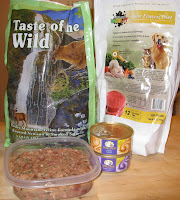1. Dry food keeps a cat's teeth clean:
If you take a minute to actually think about this statement, it's fallacies become pretty clear. Most dry food is essentially a cereal-like product. I don't know about you, but cereal (even really hard cereal, like Grape Nuts) certainly doesn't make my mouth feel fresh and clean. I can't imagine it cleaning the tarter off of my teeth, so I have no idea why it would benefit my cats in that way. Even if it did remove tarter, your cat would have to chew it in order to clean her teeth. A cat's molars are built for shearing meat off of bones, rather than chewing, so most cats opt to swallow the majority of their kibble whole rather than struggle through the chewing process. (That is, however, the way that cats eat mice, but that's another issue altogether).
Also, the unnecessarily high level of carbohydrate material in most dry foods can actually cause oral problems (the same is true of many canned foods, so you should be careful to read the ingredients) . Bil-Jac, which has long been touted as a high-quality food actually contains (are you ready for this?) cane molasses. Follow this link to their page if you want to see for yourself. Sugar, which is unhealthy even for omnivorous humans, is a terrible addition to a cat's diet and can even lead to diabetes.
If your veterinarian has recommended dry food for your cat's oral health, she was probably just repeating what the food reps said or what he read in a pamphlet. If you look into the matter (and I invite you to do so) you will find that most of the "studies" that find that dry food beneficial to cats were funded, if not run completely, by a pet food manufacturer. Remember (and this is true of all aspects of life): a research study's published results will almost always be supportive of the company that pays for it. I'd be interested in seeing a third-party study done on this topic... but who is going to pay for that?
2. I'm afraid to switch because that will upset my cat's stomach.
I'm a big fan of analogies, and I've got a pretty good one for this situation. Imagine if, for every meal, every day, for three years in a row all you ate was a ham, cheese, and lettuce sandwich on white bread with an apple and, if you got a treat, it was usually graham crackers. Now imagine, after three years on this diet, you are suddenly switched over to meals consisting of steak, baked sweet potatoes, steamed broccoli with cheese sauce, and an orange with treats of almonds and grapes. Both diets represent the four food groups and can therefore be declared "complete" although the latter is a much healthier option. However, after three years of ham sandwiches, your new diet, as healthy as it is, will certainly upset your stomach.
That's what we do to our pets. We feed them one brand of food, often without even switching varieties, for years and then blame a new food if it makes them sick. If your cat has been on one type of food for a period of time, you will need to introduce the new food gradually. If your cat is particularly sensitive, I would feed a 3/4 portion of the old food mixed with a 1/4 portion of the new for one week. Then I would do half and half for a week, and finally 1/4 old and 3/4 new for the final week before switching completely onto the new food.
 3. Cats have been domesticated long enough that evolution has enabled them to do well on dry food.
3. Cats have been domesticated long enough that evolution has enabled them to do well on dry food.Yes, I've actually heard this argument in real life.
While I generally assume that most people know better, I'm including this gross misunderstanding "just in case." Yes, cats have been domesticated for thousands of years, which may have been enough time for some small evolutionary changes to occur. Maybe. That said, cats have only been fed a commercial diet since the mid 1950's, which isn't enough time for evolution to even think about kicking in. Prior to that, cats were kept around to catch mice, which is how they became domesticated to begin with.
Animals go where their food is, so mice began to live in and around human dwellings where there was a steady supply of food to steal and cats followed the mice. This was good for both cats and humans, so domestication occurred. This arrangement worked for thousands of years and when mice became less of a problem, cats were fed meat scraps in addition to whatever they could catch or find. In the 1950's, however, the commercial pet food industry really took off, and feeding cats and dogs became more convenient than ever. These animals have been paying for it ever since.

Cats I think are desert animals. The urge to drink is not as overwhelming as we would ordinarily think. I do a skin check on my cats now and again, a pitch and a sense of how long the skin takes to return to its former shape. If it takes too long, then sometimes they need water. I make surest of adequate water by giving them wetfood now and again daily though. I have not yet met a cat that dislikes Sheba for example. A treat for them and they know this. Then they get their dry food. With losts of water. I have a fountain that splatters over rocks. Our cats love to drink off the rocks.
ReplyDelete